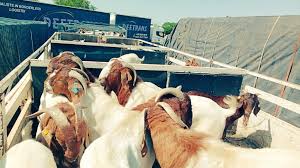Importance of weighing in goats, sheep production
Farmer’s Diary
Weighing animals is a cornerstone of effective livestock management in goat and sheep production, yet it is often overlooked.
Accurate weight measurement is vital for administering the correct medication dosages, optimising feeding, managing breeding programmes and making informed decisions that drive the success of a farm.
This week’s article examines the importance of constantly weighing your goats and sheep, the methods available for doing so, and how this practice contributes to the overall well-being of the animals and the economic viability of a farm.
Methods and tools for determining accurate livestock weight
Accurately determining the weight of your goats and sheep is the foundation of effective livestock management.
This can be done using two primary methods, namely a livestock scale or a weight belt.
The most reliable way to weigh goats and sheep is with a scale specifically designed for livestock.
These scales provide precise measurements, which are essential for critical management decisions.
Regular weighing allows farmers to track growth rates, detect health issues early, and make informed choices about feeding and breeding.
For farmers without access to a livestock scale, a weight belt provides a practical alternative for estimating an animal’s weight.
The weight belt is placed around the girth of the goat or sheep, and the weight is read off the belt. This method works because there is a known relationship between the girth circumference and the weight of the animal.
However, farmers need to remember that weight belts are tailored to specific animal types, and their accuracy may vary depending on the breed and size of the goat or sheep.
Both methods have their advantages, but for the most accurate results, especially when precise weight measurements are important, the use of a scale is recommended.
Correct dosage-to-weight
Administering medication to livestock is a routine aspect of farm management, but it must be done with care to ensure the health and safety of the animals. One of the most critical factors in effective medication is the dosage-to-weight ratio.
Most medications, whether administered orally or by injection, are dosed based on the animal’s weight. A heavier animal requires a higher dose, while a lighter one needs a lower dose.
If the dosage is not accurate, the medication may not work as intended. Under-dosing, in particular, can be problematic. Not only might the medication fail to treat the condition, but it can also lead to resistance in the pathogens you are trying to eliminate.
This means that even when the correct dosage is administered later, the medication may no longer be effective.
Practical tips for dosing
Oral dosing is a common method for administering medication to livestock by delivering it through the animal’s mouth. This technique is frequently used for dewormers, antibiotics, and supplements.
Accurate dosing requires reliable weight estimation of the animals.
When treating a group, it is advisable to dose based on the heaviest animal or to divide the herd into similarly sized groups and calculate dosages for each group.
This approach helps minimise the risk of under-dosing and ensures that all animals receive the correct amount of medication.
Medications can be given in various forms, including liquids, tablets, or boluses—large solid medications designed to be swallowed whole.
Liquid medications are typically administered with a drenching gun or syringe for precise dosing, while tablets or boluses are given using a balling gun to safely push the medication down the throat. Ensuring that the animal swallowing the entire dose is crucial for achieving the desired therapeutic effect.
When administering oral medication, consider the animal’s weight, health status, and stress levels.
Accurate weight measurement is vital to avoid ineffective treatment or toxicity. The animal’s health can affect medication absorption and metabolism, and the dosing process can be stressful.
To minimise stress, handle the animal gently and use equipment suited to its size and temperament.
Techniques for injecting animals correctly
Injections are a common method of administering medication to livestock. However, improper injection techniques can lead to complications, such as infections or damage to the animal’s muscles. Therefore, understanding the correct injection methods is crucial.
The first injection method is subcutaneous injection, commonly used for vaccines and other medications.
When administering a subcutaneous injection, use a 20-gauge needle (22- gauge for kids) with a length of about 16 mm. It’s important to lift a fold of loose skin and insert the needle at an angle between the skin and flesh.
Care should be taken not to push the needle through the skin entirely, as this can lead to wastage of the medication.
Intramuscular injections, on the other hand, are administered directly into the muscle, usually in a fleshy part of the neck or thigh. A 20-gauge needle is typically used for adult animals, and a 22-gauge needle for kids.
Before injecting, always pull back on the syringe plunger to ensure that no blood enters the syringe, which would indicate that you’ve hit a vein. If blood is present, choose a different injection site to avoid complications.
The final method is intravenous injection, where medication is administered directly into the bloodstream via a vein, ensuring rapid absorption.
This method is ideal for medications that need quick action. Use a 20-gauge needle for adult animals and a 22-gauge needle for kids.
The needle should be inserted into a visible vein, typically the jugular or cephalic vein.
Before injecting, confirm the needle’s position by drawing back on the syringe plunger and checking for blood flow. Proper technique is crucial to avoid complications like haematomas, tissue damage or accidental injection into surrounding tissues.
Good hygiene practices
Good hygiene practices are essential when handling injections and dosing animals to prevent infection and ensure effective treatment. Cleanliness helps avoid contamination of medications, syringes, and needles, which could lead to complications such as infections or abscesses at the injection site.
Use fresh, sharp needles for each animal whenever possible to prevent disease transmission.
If reusing a needle, ensure it is sterilised by boiling it in water for at least 10 minutes to eliminate any pathogens that might be present on the needle.
In addition, before administering medication, thoroughly clean and disinfect hands, equipment, and the injection site.
Proper disposal of animal waste, such as pus, blood, hair, or flesh, is crucial in preventing the spread of infection. Waste should be burnt, buried, or disposed of in a pit toilet.
This reduces the risk of introducing pathogens and ensures the medication is delivered safely and effectively, thus protecting animal health and enhancing overall farm biosecurity.
In conclusion, regular weighing of goats and sheep is fundamental to successful livestock management, yet it is frequently neglected.
Accurate weight measurements underpin critical aspects of animal care, including correct medication dosing, optimal feeding, and effective breeding management. Employing the appropriate methods — whether using a livestock scale for precise measurements or a weight belt as a practical alternative — ensures that all animals receive the correct treatment and nutrition.
In addition, adherence to proper techniques for dosing and injecting, alongside rigorous hygiene practices, is essential to safeguard animal health and prevent complications.
Sheuneni Kurasha is the managing director of Chivara Farm, a diversified farming operation, which specialises in stud breeding for small livestock (Boer goats, Kalahari Red goats, Damara sheep and Meatmaster sheep) as well as Boran cattle. For feedback, kindly get in touch on email: kurashas@gmail.com; X: @ chivarafarm or WhatsApp: +263 77 2874 523.-herald








